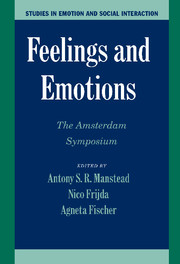Book contents
- Frontmatter
- Contents
- List of Contributors
- 1 Introduction
- PART I THE NATURE OF FEELINGS AND EMOTIONS
- PART II BASIC PSYCHOLOGICAL PROCESSES IN FEELINGS AND EMOTIONS
- PART III FEELINGS AND EMOTIONS: THE PLACE OF PLEASURE
- 14 The Affect System
- 15 Pleasure, Unfelt Affect, and Irrational Desire
- 16 Some Perspectives on Positive Feelings and Emotions
- 17 Pleasure, Utility, and Choice
- PART IV FEELINGS AND EMOTIONS IN THEIR SOCIOCULTURAL CONTEXT
- PART V FEELINGS, EMOTIONS, AND MORALITY
- Subject Index
- Author Index
- Plate section
- References
17 - Pleasure, Utility, and Choice
Published online by Cambridge University Press: 05 June 2012
- Frontmatter
- Contents
- List of Contributors
- 1 Introduction
- PART I THE NATURE OF FEELINGS AND EMOTIONS
- PART II BASIC PSYCHOLOGICAL PROCESSES IN FEELINGS AND EMOTIONS
- PART III FEELINGS AND EMOTIONS: THE PLACE OF PLEASURE
- 14 The Affect System
- 15 Pleasure, Unfelt Affect, and Irrational Desire
- 16 Some Perspectives on Positive Feelings and Emotions
- 17 Pleasure, Utility, and Choice
- PART IV FEELINGS AND EMOTIONS IN THEIR SOCIOCULTURAL CONTEXT
- PART V FEELINGS, EMOTIONS, AND MORALITY
- Subject Index
- Author Index
- Plate section
- References
Summary
ABSTRACT
When making choices, people usually imagine how they will feel about the consequences. This chapter provides an account of the anticipation process and uses it to predict choice. Decisions from several experiments are consistent with a theory in which people are assumed to evaluate alternatives by making trade-offs between predicted pleasure and pain. Then they choose the alternative with greater expected pleasure.
The field of decision making has long benefited from the interdisciplinary contributions of philosophers, economists, statisticians, and many others. These interdisciplinary contibutions can be categorized into two camps. One camp specifies how people should make choices if they wish to obey fundamental rules of logic and probability. The other camp focuses on what people actually do when making choices. While rational theories rely on beliefs and utilities, descriptive theories look to psychological processes including cognitive limitations, social norms, and cultural constraints to explain actual choices and the reasons behind alleged deviations from rationality.
Both camps are well aware that emotions influence choice. Rational theorists have addressed the question of whether emotions should influence choice, and descriptive theorists have explored how emotions influence choice. This chapter presents a descriptive account of decision making that focuses on anticipated pleasure. We propose that, when making a choice, people imagine how they will feel about future consequences. Comparisons of qualitatively different feelings are made in terms of pleasure and pain. That is, people evaluate each alternative by balancing imagined pleasure against imagined pain and select the alternative with greater average pleasure.
- Type
- Chapter
- Information
- Feelings and EmotionsThe Amsterdam Symposium, pp. 282 - 300Publisher: Cambridge University PressPrint publication year: 2004
References
- 2
- Cited by



